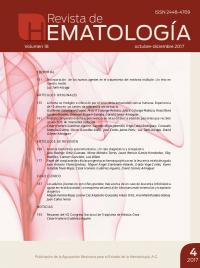Rev Hematol Mex. 2017 oct;18(4):155-160.
Sotomayor-Duque G, Colunga-Pedraza PR, Colunga-Pedraza JE, Lozano-Morales RE, Bugarín-Estrada E, Gómez-Almaguer D
Servicio de Hematología, Hospital Universitario Dr. José Eleuterio González, Universidad Autónoma de Nuevo León, Monterrey, México.
Resumen
ANTECEDENTES: la infección por el virus de la inmunodeficiencia humana (VIH) se asocia con incremento en el riesgo de linfoma no Hodgkin. Con la introducción de la terapia antirretroviral ha mejorado el pronóstico de los pacientes.
OBJETIVO: analizar el comportamiento clínico, evolución y pronóstico de los pacientes con diagnóstico de VIH y linfoma no Hodgkin en nuestro centro.
MATERIAL Y MÉTODO: estudio retrospectivo en el que se analizaron todos los pacientes con diagnóstico de linfoma no Hodgkin y VIH de 2007 a 2017, atendidos en el servicio de Hematología del Hospital Universitario Dr. José Eleuterio González, en Monterrey, Nuevo León, México. Se describen las características clínicas y la supervivencia.
RESULTADOS: se incluyeron 31 pacientes. La mediana de edad fue de 41 años (límites: 25-64), todos del sexo masculino. La variedad histológica más común fue el linfoma plasmablástico (n = 10). El tratamiento antirretroviral se prescribió en 83.8% (n = 26). El esquema de primera línea más prescrito fue R-CHOP/CHOP (n = 17). La respuesta global fue de de 43.7% (n = 14). La mediana de supervivencia fue de 8 meses (IC95% 2.89-13.1). La supervivencia global a dos años fue de 32%.
CONCLUSIONES: el diagnóstico de VIH y linfoma no Hodgkin representa un verdadero reto, se observan tasas de respuesta y supervivencia muy similares en países con recursos limitados. El tratamiento adecuado, el diagnóstico oportuno y el tratamiento antirretroviral temprano de estos pacientes resultan fundamentales.
PALABRAS CLAVE: linfoma no Hodgkin, SIDA, sistema nervioso central.
Non-Hodgkin lymphoma and infection due to human immunodeficiency virus. Ten-year experience in a university referral center.
Rev Hematol Mex. 2017 October;18(4):155-160.
Sotomayor-Duque G, Colunga-Pedraza PR, Colunga-Pedraza JE, Lozano-Morales RE, Bugarín-Estrada E, Gómez-Almaguer D
Servicio de Hematología, Hospital Universitario Dr. José Eleuterio González, Universidad Autónoma de Nuevo León, Monterrey, México.
Abstract
BACKGROUND: Human immunodeficiency virus (HIV) infection is associated with an increased risk of malignancies. With the introduction of antiretroviral therapy, prognosis has improved significantly.
OBJECTIVE: To analyze the clinical behavior, evolution and prognosis of patients diagnosed with HIV and non-Hodgkin lymphoma at our center.
MATERIAL AND METHOD: A retrospective analysis was done with all patients diagnosed with non-Hodgkin lymphoma and HIV from 2007 to 2017. We describe clinical characteristics and prognosis.
RESULTS: A total of 31 patients were included. Median age was 41 years (25-64). All patients were male. The median follow-up was 6 months (1-54). The most common histological variety was plasmablastic lymphoma (n = 10). The most frequent first-line therapy was R-CHOP/CHOP (n = 17). The global response was 43.7% (n = 14). The median survival was 8 months (95% CI 2.89-13.1). The 2-year overall survival was 32%. The main cause of death was the progression of disease (50%, n = 8).
CONCLUSIONS: The diagnosis of HIV and non-Hodgkin lymphoma represents a real challenge; the proper management, timely diagnosis and early antiretroviral treatment of these patients are essential.
KEYWORDS: lymphoma, Non-Hodgkin; AIDS; central nervous system

